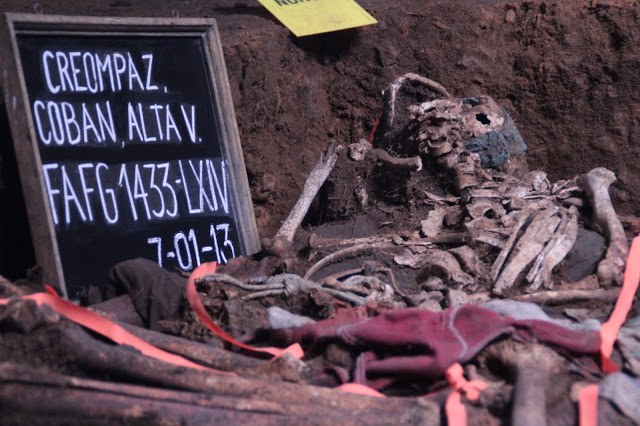Military Zone 21 – CREOMPAZ
On January 6, 2016, 14 former military officers were arrested on charges of forced disappearance and crimes against humanity based on evidence uncovered at the CREOMPAZ military center in Cobán, Alta Verapaz. Now a United Nations peacekeeper training base, CREOMPAZ (Regional Training Command for Peacekeeping Operations) operated as a detention and clandestine execution center during Guatemala’s Internal Armed Conflict, when it was known as Military Zone 21. Between 2012 and 2015, the Forensic Anthropology Foundation of Guatemala (FAFG) carried out 14 exhumations at CREOMPAZ and found 558 human remains in fourteen graves, representing the largest known case of forced disappearance in Latin America.
Spanning crimes committed from 1981 – 1988, the Military Zone 21 (CREOMPAZ) case sets the record in Guatemala, not only for the number of disappeared victims, but also for the time span over which the crimes were committed. Among the high-ranking individuals indicted is Manuel Benedicto Lucas García, who served as former Army Chief of Staff during his brother’s 1978-1982 military dictatorship, and who is currently imprisoned for his role in crimes against humanity committed against the Molina Theissen family. The trial is an important step in the legal trajectory seeking justice for crimes against humanity and represents more than 30 years of hard work by survivor organizations.
In-depth NISGUA reports
The same people who carried out genocide in Nebaj were the same who carried out genocide in Plan de Sánchez and throughout Baja and Alta Verapaz. It’s important that the high- ranking military command are tried for these crimes.
Latest from our blog
Communities denounce Xalalá dam and oil exploitation
The following press releases have been translated by NISGUA as part of its ongoing human rights accompaniment of communities threatened by the Xalalá dam project. Press Release 1 25 October 2012 Guatemala Imposition [...]
Totonicapán rising: Guatemalan military massacres K’iche protesters
The deceased, all wounded by firearm, according to Dr. Jorge Destarac, regional head of the National Forensic Science Institute, were eight in total: Rafael Batz (Pasajoc), Santos Nicolás Menchú (Pasajoc), Jesús Baltazar Caxaj Puac [...]
Indigenous protesters killed in Totonicapan, Guatemala
At least six protesters were killed and dozens wounded this afternoon in repression of a protest organized by the representatives of 48 indigenous K'iche communities of Totonicapan, Guatemala. According to Guatemala Indymedia Center and social movement organizations, the protesters [...]
“Otro golpe al pueblo maya, al estilo mano dura”
Otro golpe al pueblo maya, al estilo mano duraPor la Asamblea de pueblos de Huehuetenango por la Defensa del Territorio, ADH - Huehuetenango, 4 de octubre de 2012La asamblea de pueblos de Huehuetenango –ADH-; a la [...]
“Another blow to the Maya people, in the style of Mano Dura”
Another blow to the Maya people, in the style of Mano DuraStatement by the Departmental Assembly of HuehuetenangoOctober 4, 2012The Departmental Assembly of Huehuetenango -ADH- before national and international public opinion, DECLARES:Our profound outrage for [...]
Criminalization and Violence Erupt in the Shadow of the Escobal Mine
In recent weeks the municipality of San Rafael Las Flores has seen growing conflict around the installation of the Escobal silver mine, owned by the Canadian corporation Tahoe Resources. Local community organizers and allies [...]


